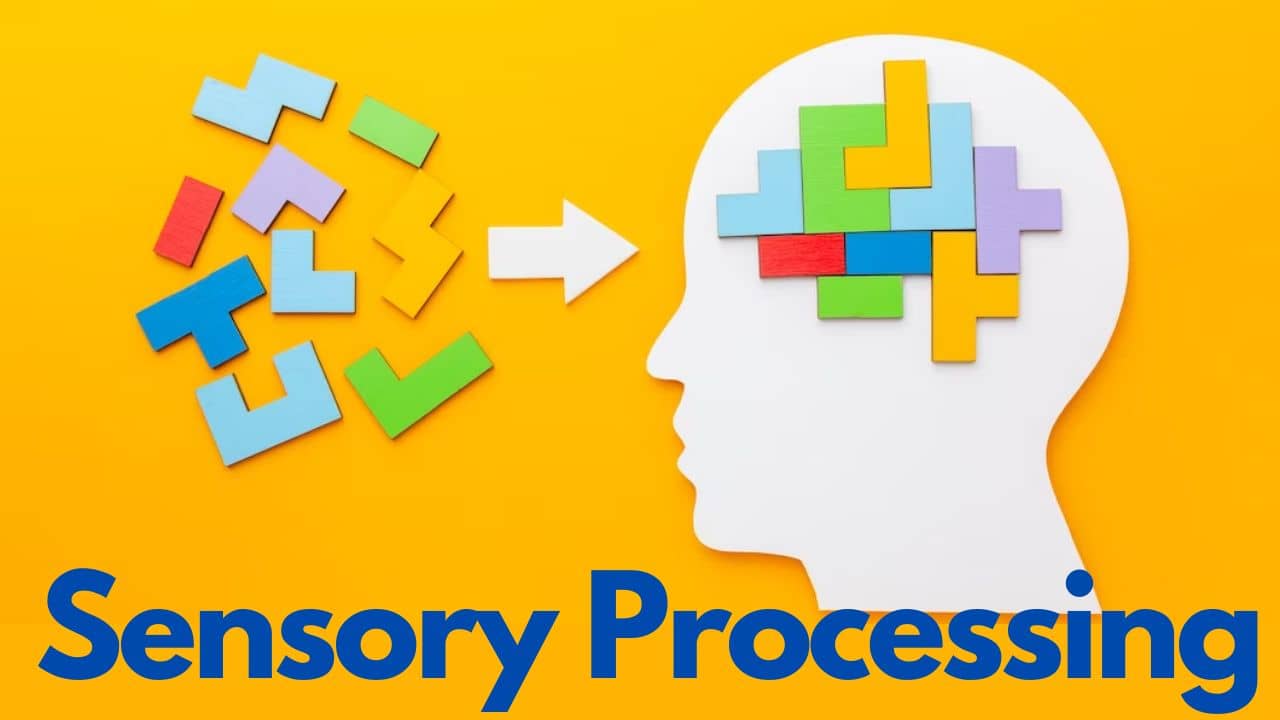Autism spectrum disorder (ASD) is a complex neurodevelopmental condition that affects individuals in various ways. One aspect that significantly impacts the lives of people with autism is sensory processing. Sensory processing in autism refers to the unique and often heightened or diminished ways in which individuals with autism experience sensory stimuli from their environment.
In this article, we will delve into the intricacies of sensory processing in autism, exploring its effects and providing practical strategies for better understanding and supporting individuals on the spectrum.
The Sensory Processing in Autism
Individuals with autism often exhibit a wide range of sensory sensitivities. These sensitivities can involve any of the five main senses: sight, sound, touch, taste, and smell. For some, certain stimuli can be overwhelming, leading to sensory overload, anxiety, and meltdowns. On the other hand, some individuals may have a higher threshold for sensory input, leading to sensory-seeking behaviors like Stimming, which are repetitive movements or actions that help regulate sensory input.
- Visual Sensitivities: Many individuals with autism have heightened visual sensitivities, which can lead to discomfort or difficulty in processing visual information. Bright lights, intense colors, or rapid movements may cause distress or agitation.
- Auditory Sensitivities: Sound sensitivities are also common in autism. Background noises that neurotypical individuals might not notice could be distressing or overwhelming for someone with autism. Loud environments, sudden noises, or crowded spaces can be particularly challenging.
- Tactile Sensitivities: The sense of touch can be another area of sensitivity. Some individuals may be hypersensitive to certain textures, fabrics, or physical contact, while others might seek out specific textures or sensations for comfort.
- Taste and Smell Sensitivities: Unusual reactions to taste and smell can also be present. Some individuals may be extremely selective in their food choices due to sensitivities to taste or smell, while others might not react to strong smells that would bother neurotypical individuals.
Understanding Sensory Processing Challenges
It’s crucial to recognize that sensory processing differences in autism are not uniform. What bothers one individual might not affect another in the same way. Moreover, sensory sensitivities can vary over time and in different environments. To provide effective support, it’s essential to observe and communicate with individuals to understand their unique sensory experiences.
Here are some key points about sensory processing in autism:
1. Sensory Sensitivities
Sensory processing refers to the way our nervous system receives, interprets, and responds to sensory information from the environment. It involves our five main senses: sight, hearing, touch, taste, and smell, as well as other sensory systems that help us maintain balance, body awareness, and movement control. In individuals with autism spectrum disorder (ASD), sensory processing can be significantly affected, leading to sensory sensitivities or sensory-seeking behaviors.
Many individuals with autism experience sensory sensitivities, meaning certain sensory inputs are perceived as overwhelming or distressing. For example, they may be hypersensitive to loud noises, bright lights, certain textures, or strong smells. These sensitivities can lead to feelings of discomfort, anxiety, or even physical pain.
Types of Sensory Sensitivities:
- Hypersensitivity (Over responsiveness): This involves a heightened reaction to stimuli. For example, a person with auditory hypersensitivity might find ordinary sounds, like a door closing or a car horn, extremely loud and distressing.
- Hyposensitivity (Under responsiveness): This is the opposite, where an individual has a diminished response to sensory stimuli. They might seek out intense sensory experiences to feel sensations more strongly. An example is a person who enjoys extremely spicy foods because they need a strong taste sensation to feel satisfied.
2. Sensory Seeking Behaviors
Sensory seeking behaviors refer to actions or behaviors exhibited by individuals who actively seek out and engage with sensory stimuli in order to satisfy their sensory needs. These behaviors are often observed in individuals with sensory processing differences, such as those with sensory processing disorder (SPD) or autism spectrum disorder (ASD), but they can also be present in people without any diagnosed condition. Sensory seeking behaviors are a way for individuals to regulate their sensory experiences and engage with their environment.
Here are some examples and elaborations on sensory seeking behaviors:
a. Vestibular Seeking:
- Activities that involve movement, such as swinging, spinning, or rocking.
- Jumping on trampolines or engaging in activities that provide a sense of motion.
b. Tactile Seeking:
- Enjoying touching different textures, such as fabrics, surfaces, or objects with interesting tactile properties.
- Seeking out deep pressure through activities like hugging, squeezing, or using weighted blankets.
c. Auditory Seeking:
- Being drawn to and seeking out certain sounds or noises, such as tapping, humming, or repetitive sounds.
- Enjoying music played at high volumes or engaging in activities that produce auditory stimulation.
d. Visual Seeking:
- Engaging with visual stimuli like bright lights, spinning objects, or visual patterns.
- Enjoying activities that involve watching moving visuals, such as spinning fans or moving water.
e. Proprioceptive Seeking:
- Seeking out activities that provide strong muscle and joint input, such as heavy lifting, pushing, or pulling.
- Engaging in activities that involve crashing into objects or engaging with resistance.
f. Olfactory and Gustatory Seeking:
- Seeking out strong or distinct smells, such as sniffing objects or foods.
- Enjoying intense flavors or foods with strong tastes.
g. Social Seeking:
- Seeking out social interactions to engage in sensory-rich experiences.
- Participating in group activities or events that involve physical contact or close proximity to others.
It’s important to note that sensory seeking behaviors can vary widely from person to person. Some individuals may exhibit more pronounced sensory seeking behaviors, while others may show fewer or more subtle signs. Sensory seeking behaviors can serve as a way for individuals to self-regulate and manage their sensory experiences. However, excessive or disruptive sensory seeking behaviors may impact daily functioning or social interactions.
Occupational therapists and other professionals who specialize in sensory processing can provide guidance and strategies to help individuals manage their sensory seeking behaviors in a constructive and positive way. Creating sensory-friendly environments and providing appropriate sensory outlets can also be beneficial in supporting individuals with sensory seeking tendencies.
3. Hyposensitivity
Hyposensitivity, also known as sensory under responsiveness or sensory seeking, is a condition characterized by a decreased sensitivity to sensory stimuli. Individuals with hyposensitivity may have difficulty perceiving, processing, or responding to sensory input in the same way as others. This condition is often associated with sensory processing differences and can be observed in various sensory modalities such as touch, sound, taste, smell, sight, and movement. Hyposensitivity can be a feature of conditions like sensory processing disorder (SPD) and autism spectrum disorder (ASD), but it can also occur independently.
Some individuals with autism may also show hyposensitivity, which means they have a reduced response to sensory stimuli. They might not react to pain or extreme temperatures as expected, or they may engage in self-stimulatory behaviors (Stimming) as a way to modulate sensory input.
4. Impact on Behavior
Sensory processing plays a significant role in shaping an individual’s behavior, reactions, and interactions with the environment. When an individual’s sensory processing is atypical, whether it’s due to sensory sensitivities, hyposensitivity, or other factors, it can have a profound impact on their behavior and overall well-being.
Here are some ways in which sensory processing can impact behavior:
a. Emotional Regulation:
Sensory processing difficulties can affect emotional regulation. For example:
- Individuals with sensory sensitivities might become overwhelmed by sensory stimuli, leading to emotional responses like anxiety, irritability, or meltdowns.
- Those with hyposensitivity might engage in seeking behaviors to stimulate their senses and regulate their emotions.
b. Social Interactions:
Sensory processing can influence how individuals interact with others:
- Sensory sensitivities might lead to avoidance of social situations or difficulty engaging in group activities due to fear of overwhelming sensory input.
- Hyposensitivity can impact social interactions by causing individuals to miss subtle social cues, gestures, or expressions.
c. Communication:
- Individuals with sensory processing differences might have difficulty focusing on verbal communication if their sensory environment is distracting or overwhelming.
- Hyposensitivity might affect an individual’s ability to notice and interpret nonverbal cues during conversations.
d. Self-Care and Daily Activities:
- Sensory sensitivities can impact an individual’s ability to engage in self-care activities such as grooming or dressing due to aversions to certain textures or sensations.
- Hyposensitivity might lead to challenges in recognizing when clothing is uncomfortable or adjusting one’s behavior based on sensory feedback.
e. Attention and Concentration:
- Sensory sensitivities can lead to sensory overload, which in turn can affect an individual’s ability to focus and concentrate on tasks.
- Hyposensitivity might result in seeking out intense sensory input to stay alert and engaged.
f. Engagement and Participation:
- Sensory sensitivities can lead to avoidance of activities or environments that trigger discomfort, limiting an individual’s engagement and participation.
- Hyposensitivity might result in seeking out activities that provide intense sensory input, possibly leading to repetitive or self-stimulatory behaviors.
g. Risk Perception and Safety:
- Hyposensitivity can impact an individual’s ability to perceive potential dangers in their environment, leading to risky behaviors due to reduced awareness of hazards.
- Sensory sensitivities might cause an individual to react strongly to sensory triggers that others might perceive as harmless, affecting their sense of safety.
h. Coping Mechanisms:
- Individuals with sensory processing differences might develop specific coping mechanisms to manage their sensory experiences, such as seeking out quiet spaces, using sensory tools, or engaging in repetitive behaviors.
Understanding an individual’s sensory profile is crucial for caregivers, educators, and healthcare professionals to provide appropriate support and interventions. Addressing sensory processing differences can lead to improved emotional well-being, social interactions, and overall quality of life for individuals with these challenges. Occupational therapy and sensory integration techniques are commonly used to help individuals develop effective strategies for managing their sensory processing and its impact on behavior.
5. Individual Differences
Sensory processing differences in individuals with autism spectrum disorder (ASD) are known to be highly varied and unique. These differences contribute to the wide range of behaviors, preferences, and challenges observed in people on the autism spectrum. Here are some key points highlighting the individual differences in sensory processing among individuals with autism:
a. Sensory Profiles Vary:
No two individuals with autism have the exact same sensory profile. Some individuals might exhibit hypersensitivity (overresponsiveness) to certain sensory stimuli, while others might show hyposensitivity (underresponsiveness) or sensory seeking behaviors.
b. Differences Across Sensory Modalities:
- Individuals with autism may experience differences in sensory processing across various modalities:
- Some might have heightened sensitivity to certain sounds, leading to distress or discomfort in noisy environments.
- Others might struggle with tactile sensitivities, finding certain textures or clothing materials intolerable.
- Visual sensitivities could result in aversions to bright lights or busy visual environments.
- Gustatory and olfactory sensitivities could lead to strong preferences for or aversions to certain tastes and smells.
c. Sensory Overload and Meltdowns:
For some individuals with autism, sensory sensitivities can lead to sensory overload, which can result in meltdowns or shutdowns. Sensory overload occurs when the brain is unable to filter and process sensory information effectively, leading to heightened stress and emotional responses.
d. Sensory Seeking and Self-Stimulation:
Many individuals with autism engage in sensory seeking behaviors as a way to regulate their sensory experiences. These behaviors can include repetitive movements (stimming), seeking tactile sensations, or engaging in activities that provide intense sensory input.
e. Impact on Communication and Social Interaction:
- Sensory processing differences can impact communication and social interactions:
- Difficulty with processing auditory information might affect the ability to filter out background noise during conversations.
- Challenges in recognizing facial expressions and nonverbal cues can affect social understanding.
- Hypersensitivity to touch might make physical contact during interactions uncomfortable.
f. Environmental Preferences:
Individuals with autism might have specific preferences for certain sensory environments. Some may seek out quiet, dimly lit spaces to minimize sensory input, while others might enjoy intense sensory experiences.
g. Fluctuations in Sensory Sensitivities:
Sensory sensitivities in individuals with autism can vary day to day or even throughout a single day. Factors like fatigue, stress, or changes in routine can influence how sensory stimuli are perceived and processed.
h. Individualized Strategies and Support:
Recognizing and respecting an individual’s sensory differences is crucial. Occupational therapists often work with individuals with autism to develop personalized strategies for managing sensory sensitivities and promoting self-regulation.
i. Positive Aspects:
It’s important to note that sensory processing differences in autism are not exclusively negative. Some individuals might possess heightened sensory awareness that allows them to notice details that others might miss. Additionally, sensory interests and preferences can be sources of joy and engagement.
Understanding and accommodating these individual differences is vital in providing effective support, creating sensory-friendly environments, and promoting the well-being of individuals with autism.
6. Occupational Therapy
Occupational therapy (OT) plays a crucial role in addressing sensory processing differences in individuals with autism spectrum disorder (ASD). Occupational therapists who specialize in sensory integration focus on helping individuals with ASD develop effective strategies to process sensory information, regulate their responses, and engage more comfortably with their environment.
Occupational therapists begin by conducting thorough assessments to understand an individual’s sensory profile. This involves identifying specific sensory sensitivities, seeking behaviors, and how sensory processing challenges impact the individual’s daily life.
Based on the assessment, occupational therapists create individualized intervention plans tailored to the person’s sensory needs and goals. The goal is to help the individual better adapt to their environment, regulate sensory responses, and engage in meaningful activities.
The focus of occupational therapy is to help individuals with autism improve their ability to engage in meaningful activities and daily routines despite sensory challenges. It’s important to remember that each individual with autism has unique sensory needs, and occupational therapy interventions are tailored to meet those specific needs.
7. Sensory Integration Therapy
Sensory Integration Therapy (SIT) is a type of intervention commonly used by occupational therapists to address sensory processing challenges, particularly in individuals with conditions like autism spectrum disorder (ASD) and sensory processing disorder (SPD). The goal of sensory integration therapy is to help individuals develop more effective sensory processing and improve their ability to interact with their environment in a more adaptive and comfortable manner. Here’s an overview of sensory integration therapy:
Sensory integration therapy is based on the sensory integration theory developed by occupational therapist Dr. Jean Ayres. This theory emphasizes the brain’s ability to process and integrate sensory information from various sources, including touch, movement, sight, sound, and more. According to this theory, a well-functioning sensory system is crucial for daily functioning and learning.
Goals of Sensory Integration Therapy:
- Improve sensory modulation: Help individuals regulate their responses to sensory stimuli by either calming overresponsive reactions or stimulating underresponsive ones.
- Enhance sensory discrimination: Help individuals differentiate between different sensory inputs to improve their ability to understand and respond to the environment.
- Promote adaptive responses: Help individuals generate appropriate responses to sensory stimuli, which supports effective engagement in activities and interactions.
It’s essential to understand that sensory processing differences are just one aspect of autism. Each individual with autism is unique, and their sensory experiences can vary widely. As with any aspect of autism, early identification and appropriate support can be beneficial in helping individuals navigate the sensory challenges they may face and improve their overall quality of life. If you or someone you know is seeking assistance, it’s recommended to consult with professionals experienced in working with autism and sensory processing difficulties.





